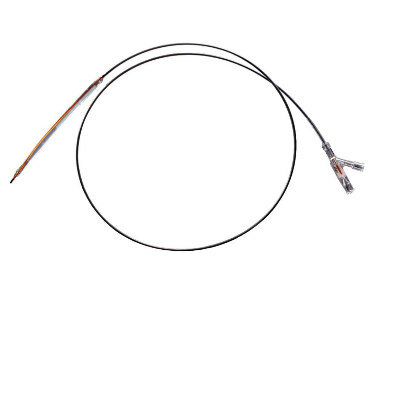Fatty Acid Levels Could Help Predict Psychosis Risk
|
By HospiMedica International staff writers Posted on 03 Nov 2016 |

Image: The Scream by Edvard Munch (Photo courtesy of the National Gallery in Oslo, Norway).
A novel probabilistic model that combines history, clinical assessment, and fatty-acid biomarkers could help predict transition to first-episode psychosis, claims a new study.
Researchers at the University of Adelaide (UA; Australia), the Medical University of Vienna (Austria), and other institutions conducted a study in 40 patients in Austria to explore if a probabilistic model that combine medical historical, clinical risk factors, oxidative stress and cell membrane fatty acids biomarkers, and resting quantitative electroencephalography (qEEG), could improve the identification of patients with ultra-high risk (UHR) of psychosis.
The researchers then analyzed concurrent and baseline data of the study cohort, who overall exhibited a 28% one-year transition rate to psychosis. They then clustered several significant variables into historical (history of drug use), clinical (Positive and Negative Symptoms Scale [PNSS] and Global Assessment of Function [GAF] scores), and biomarker (total omega-3, nervonic acid) groups, and calculated the post-test probability of transition for each group separately and for group combinations, using the odds ratio form of Bayes’ rule.
The results showed that the combination of all three variable groups vastly improved the specificity of prediction. The model identified over 70% of UHR patients who transitioned within one year, compared with 28% identified by standard UHR criteria. The model classified 77% of cases as very high or low risk based on history and clinical assessment, suggesting that a staged approach, which reserved fatty-acid markers for 23% of cases remaining at intermediate probability following bedside interview, could be the most efficient. The study was published on September 20, 2016, in the Translational Psychiatry.
“Currently, all patients in the ultra-high risk group are considered to have a similar chance of a future psychotic episode; however, we have been able to identify high, intermediate and low-risk groups. The model may help clinicians to decide when a patient's risk of psychosis outweighs any side effects of treatment,” said lead author psychiatrist Scott Clark, MD, of the University of Adelaide. “Fatty acids such as omega-3 and nervonic acid are critical for the normal functioning of the brain, and low levels have been associated with the development of psychosis in high-risk groups.”
The concept of clinical UHR for psychosis was developed to facilitate early detection and intervention, and is defined by a cluster of subthreshold psychotic symptoms. These can include perceptions, such as hallucinations; thinking - for example, ideas of reference, odd beliefs, or magical thinking; and trait risk factors like a family history of psychosis. These are accompanied by impairment in day-to-day function. In recent meta-analysis, studies show that less than 30% of UHR patients will have transitioned to psychosis three years after identification.
Related Links:
University of Adelaide
Medical University of Vienna
Researchers at the University of Adelaide (UA; Australia), the Medical University of Vienna (Austria), and other institutions conducted a study in 40 patients in Austria to explore if a probabilistic model that combine medical historical, clinical risk factors, oxidative stress and cell membrane fatty acids biomarkers, and resting quantitative electroencephalography (qEEG), could improve the identification of patients with ultra-high risk (UHR) of psychosis.
The researchers then analyzed concurrent and baseline data of the study cohort, who overall exhibited a 28% one-year transition rate to psychosis. They then clustered several significant variables into historical (history of drug use), clinical (Positive and Negative Symptoms Scale [PNSS] and Global Assessment of Function [GAF] scores), and biomarker (total omega-3, nervonic acid) groups, and calculated the post-test probability of transition for each group separately and for group combinations, using the odds ratio form of Bayes’ rule.
The results showed that the combination of all three variable groups vastly improved the specificity of prediction. The model identified over 70% of UHR patients who transitioned within one year, compared with 28% identified by standard UHR criteria. The model classified 77% of cases as very high or low risk based on history and clinical assessment, suggesting that a staged approach, which reserved fatty-acid markers for 23% of cases remaining at intermediate probability following bedside interview, could be the most efficient. The study was published on September 20, 2016, in the Translational Psychiatry.
“Currently, all patients in the ultra-high risk group are considered to have a similar chance of a future psychotic episode; however, we have been able to identify high, intermediate and low-risk groups. The model may help clinicians to decide when a patient's risk of psychosis outweighs any side effects of treatment,” said lead author psychiatrist Scott Clark, MD, of the University of Adelaide. “Fatty acids such as omega-3 and nervonic acid are critical for the normal functioning of the brain, and low levels have been associated with the development of psychosis in high-risk groups.”
The concept of clinical UHR for psychosis was developed to facilitate early detection and intervention, and is defined by a cluster of subthreshold psychotic symptoms. These can include perceptions, such as hallucinations; thinking - for example, ideas of reference, odd beliefs, or magical thinking; and trait risk factors like a family history of psychosis. These are accompanied by impairment in day-to-day function. In recent meta-analysis, studies show that less than 30% of UHR patients will have transitioned to psychosis three years after identification.
Related Links:
University of Adelaide
Medical University of Vienna
Latest Critical Care News
- CPR Guidelines Updated for Pediatric and Neonatal Emergency Care and Resuscitation
- Ingestible Capsule Monitors Intestinal Inflammation
- Wireless Implantable Sensor Enables Continuous Endoleak Monitoring
- Pulse Oximeter Index Offers Non-Invasive Guides for Fluid Therapy
- Wearable Patch for Early Skin Cancer Detection to Reduce Unnecessary Biopsies
- 'Universal' Kidney to Match Any Blood Type
- Light-Based Technology to Measure Brain Blood Flow Could Diagnose Stroke and TBI
- AI Heart Attack Risk Assessment Tool Outperforms Existing Methods
- Smartphone Imaging System Enables Early Oral Cancer Detection
- Swallowable Pill-Sized Bioprinter Treats GI Tract Injuries

- Personalized Brain “Pacemakers” Could Help Patients with Hard-To-Treat Epilepsy
- Microscopic DNA Flower Robots to Enable Precision Medicine Delivery
- Origami Robots to Deliver Medicine Less Invasively and More Effectively
- Improved Cough-Detection Technology Aids Health Monitoring
- AI Identifies Children in ER Likely to Develop Sepsis Within 48 Hours
- New Radiofrequency Therapy Slows Glioblastoma Growth
Channels
Surgical Techniques
view channel
Robotic Assistant Delivers Ultra-Precision Injections with Rapid Setup Times
Age-related macular degeneration (AMD) is a leading cause of blindness worldwide, affecting nearly 200 million people, a figure expected to rise to 280 million by 2040. Current treatment involves doctors... Read more
Minimally Invasive Endoscopic Surgery Improves Severe Stroke Outcomes
Intracerebral hemorrhage, a type of stroke caused by bleeding deep within the brain, remains one of the most challenging neurological emergencies to treat. Accounting for about 15% of all strokes, it carries... Read morePatient Care
view channel
Revolutionary Automatic IV-Line Flushing Device to Enhance Infusion Care
More than 80% of in-hospital patients receive intravenous (IV) therapy. Every dose of IV medicine delivered in a small volume (<250 mL) infusion bag should be followed by subsequent flushing to ensure... Read more
VR Training Tool Combats Contamination of Portable Medical Equipment
Healthcare-associated infections (HAIs) impact one in every 31 patients, cause nearly 100,000 deaths each year, and cost USD 28.4 billion in direct medical expenses. Notably, up to 75% of these infections... Read more
Portable Biosensor Platform to Reduce Hospital-Acquired Infections
Approximately 4 million patients in the European Union acquire healthcare-associated infections (HAIs) or nosocomial infections each year, with around 37,000 deaths directly resulting from these infections,... Read moreFirst-Of-Its-Kind Portable Germicidal Light Technology Disinfects High-Touch Clinical Surfaces in Seconds
Reducing healthcare-acquired infections (HAIs) remains a pressing issue within global healthcare systems. In the United States alone, 1.7 million patients contract HAIs annually, leading to approximately... Read moreHealth IT
view channel
Printable Molecule-Selective Nanoparticles Enable Mass Production of Wearable Biosensors
The future of medicine is likely to focus on the personalization of healthcare—understanding exactly what an individual requires and delivering the appropriate combination of nutrients, metabolites, and... Read moreBusiness
view channel
Philips and Masimo Partner to Advance Patient Monitoring Measurement Technologies
Royal Philips (Amsterdam, Netherlands) and Masimo (Irvine, California, USA) have renewed their multi-year strategic collaboration, combining Philips’ expertise in patient monitoring with Masimo’s noninvasive... Read more
B. Braun Acquires Digital Microsurgery Company True Digital Surgery
The high-end microsurgery market in neurosurgery, spine, and ENT is undergoing a significant transformation. Traditional analog microscopes are giving way to digital exoscopes, which provide improved visualization,... Read more
CMEF 2025 to Promote Holistic and High-Quality Development of Medical and Health Industry
The 92nd China International Medical Equipment Fair (CMEF 2025) Autumn Exhibition is scheduled to be held from September 26 to 29 at the China Import and Export Fair Complex (Canton Fair Complex) in Guangzhou.... Read more














